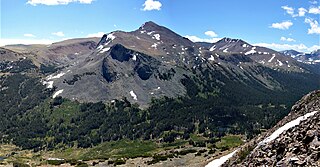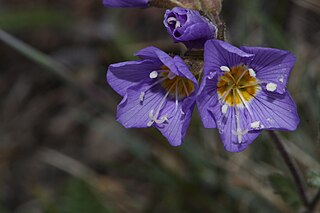
Mount Dana is a mountain in the U.S. state of California. Its summit marks the eastern boundary of Yosemite National Park and the western boundary of the Ansel Adams Wilderness. At an elevation of 13,061 feet (3,981 m), it is the second highest mountain in Yosemite, and the northernmost summit in the Sierra Nevada which is over 13,000 feet (3,962.4 m) in elevation. Mount Dana is the highest peak in Yosemite that is a simple hike to the summit. The mountain is named in honor of James Dwight Dana, who was a professor of natural history and geology at Yale.

Polemonium reptans is a perennial herbaceous plant native to eastern North America. Common names include spreading Jacob's ladder, creeping Jacob's ladder, false Jacob's ladder, abscess root, American Greek valerian, blue bells, stairway to heaven, and sweatroot.

The Rose Parade, also known as the Tournament of Roses Parade, is an annual parade held mostly along Colorado Boulevard in Pasadena, California, United States, on New Year's Day.

Polemonium, commonly called Jacob's ladders or Jacob's-ladders, is a genus of between 25 and 40 species of flowering plants in the family Polemoniaceae, native to cool temperate to arctic regions of the Northern Hemisphere. One species also occurs in the southern Andes in South America. Many of the species grow at high altitudes, in mountainous areas. Most of the uncertainty in the number of species relates to those in Eurasia, many of which have been synonymized with Polemonium caeruleum.

Provo Municipal Airport is a public-use airport two miles [3.2 km] west of Provo, in Utah County, Utah. It is a small regional airport with domestic flights mainly to destinations in the western United States.

Polemonium viscosum, known as sky pilot, skunkweed, sticky Jacobs-ladder, and sticky polemonium, is a flowering plant in the genus Polemonium native to western North America from southern British Columbia east to Montana and south to Arizona and New Mexico, where it grows at high altitudes on dry, rocky sites.

North Palisade is the third-highest mountain in the Sierra Nevada range of California, and one of the state's small number of peaks over 14,000 feet, known as fourteeners. It is the highest peak of the Palisades group of peaks in the central part of the Sierra range. It sports a small glacier and several highly prized rock climbing routes on its northeast side.

Polemonium carneum is a plant native to the northwestern United States west of the crest of the Cascade Range, from Washington south through Oregon to the San Francisco Bay Area in California.

Polemonium eximium, the skypilot or showy sky pilot, is a perennial plant in the phlox family (Polemoniaceae) that grows at high altitudes. It is endemic to the Sierra Nevada in California where it grows in the talus of the high mountain slopes.

Polemonium californicum is a species of flowering plant in the phlox family known by the common names moving polemonium, low Jacob's-ladder, and California Jacob's ladder. It is native to the northwestern United States, where it grows in shady and moist habitat, such as mountain woodlands. It is a hairy, glandular rhizomatous perennial herb forming clumps of several decumbent to erect stems 30 to 50 centimeters in maximum height. The leaves are up to 20 centimeters long and are compound, made up of several pairs of oval to lance-shaped leaflets. The leaflet at the tip of the leaf is often fused to the pair behind it. The inflorescence is a crowded cluster of bell-shaped flowers each up to 1.5 centimeters wide. The flower is blue or purple with a yellow center and a whitish tubular throat. The fruit is a capsule.

Polemonium chartaceum is a rare species of flowering plant in the phlox family known by the common names Mason's Jacob's-ladder and Mason's sky pilot. It is native to California, where it has a disjunct distribution. It occurs in the Klamath Mountains as well as the ranges east of the Sierra Nevada, including the White Mountains, where its distribution extends just into Nevada. It is a plant of high elevations, growing in exposed, rocky mountain slope habitat such as talus and alpine fellfields.

Polemonium micranthum is a species of flowering plant in the phlox family known by the common names annual polemonium or annual Jacob's-ladder. It is native to western North America from British Columbia to North Dakota to California as well as disjunct in the Andes of southern Argentina and Chile. It can be found in many types of shrubby habitat, such as sagebrush scrub and foothill woodlands. It is an annual herb with a branching or unbranched stem taking a matted, spreading, or upright form. The slender stems are up to about 30 centimeters long and the herbage is coated in short, soft hairs and stalked glands. The leaves are located along the stem, each divided into several small leaflets. The solitary flowers have small white or pale blue lobed corollas tucked within cuplike calyces of hairy, pointed sepals.

Polemonium occidentale is a species of flowering plant in the phlox family known by the common names western polemonium and western Jacob's-ladder. There are two subspecies. The common ssp. occidentale is native to western North America from British Columbia to Colorado to California, where it can be found in moist areas of many habitat types, including meadows and woodlands. There is also a rare subspecies, ssp. lacustre, which is known only from a total of three counties in Minnesota and Wisconsin, and is found only in white cedar swamp habitat there.

Polemonium pulcherrimum is a species of flowering plant in the phlox family known by several common names, including beautiful Jacob's-ladder, showy Jacob's-ladder, and skunk-leaved polemonium. It is native to western North America from Alaska and Yukon to Arizona and New Mexico, where it can be found in many types of mountain habitat, including alpine talus and rock cracks at high elevations. It is a common and widespread wildflower in several regions. It is a perennial herb producing a clump of several erect stem approaching a maximum height of 30 centimeters. The leaves are mostly basal, with smaller ones arranged along the stem. The leaves are made up of several pairs of lance-shaped to oval or round leaflets. The herbage is lightly hairy, densely glandular, sticky, and strongly scented, the odor reminiscent of skunk. The showy inflorescence is a dense elongated or headlike cluster of bell-shaped flowers each just under a centimeter wide. The flower is deep to bright or pale blue to nearly white with a yellow throat.

Grays Peak National Recreation Trail or Grays Peak Trail lies along the Continental Divide of the Americas, part of the Rocky Mountains in the U.S. state of Colorado. It is located in the White River National Forest, Summit County. Grays Peak Trail is south of Interstate 70, east of Keystone Resort and near Montezuma. Grays Peak is adjacent to Torreys Peak. The Grays Peak Trail begins 3 miles above Interstate 70, at 11,200 feet. The summit of Grays Peak is 3.7 miles from the trailhead. Torreys Peak is 4.15 miles from the trailhead, across a saddle from Grays Peak. Grays Peak Trail ascends south through the wetland willows of Stevens Gulch. The trail passes between Stevens Mine on a lower slope of McClellan Mountain, 13,587 feet, forming the eastern wall of the valley, and Sterling Silver Group Mine beside the trail to the right on Kelso Mountain, 13,164 feet. The trail climbs 900 feet during the first 1.7 miles to a National Recreation Trail sign indicating that the summit is two miles farther.
Cymopterus goodrichii is a rare species of flowering plant in the carrot family known by the common name Toiyabe springparsley. It is endemic to Nevada in the United States, where it occurs in the Toiyabe and West Humboldt Ranges.
Packera castoreus is a rare species of flowering plant in the aster family known by the common names Beaver Mountain groundsel and Beaver Mountain ragwort. It is endemic to Utah in the United States, where it occurs only in the Tushar Mountains.

The flora of the U.S. Sierra Nevada alpine zone is characterized by small, low growing, cushion and mat forming plants that can survive the harsh conditions in the high-altitude alpine zone above the timber line. These flora often occur in alpine fell-fields. The Sierra Nevada alpine zone lacks a dominant plant species that characterizes it, so may or may not be called a vegetation type. But it is found above the subalpine forest, which is the highest in a succession of recognized vegetation types at increasing elevations.















